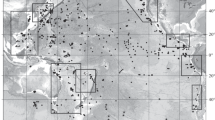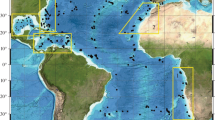Abstract
We have done a comparative analysis of quantitative parameters for Pleistocene sediments from pelagic zone of the Indian Ocean and submarine parts of its continental margins (for five key areas). The distribution areas, thicknesses, and volumes of main lithological types and groups have been analyzed. Dry sediment masses and their accumulation rates have been calculated. In the Neopleistocene compared to Eopleistocene, the fluxes (absolute masses) of all components of bottom sediments have been increased both in the pelagic zone and on the continental margins. Biogenic sedimentation was more important for facies structure of pelagic zone than (on average) for continental margins.

Similar content being viewed by others
REFERENCES
P. L. Bezrukov and A. P. Lisitzin, “Map of the surface layer of bottom sediments,” International Geological-Geophysical Atlas of the Indian Ocean, Ed. by G. B. Udintsev (GUGK USSR, Moscow, 1974), pp. 135–136 [in Russian].
M. A. Levitan, “Comparative analysis of Pleistocene sediments of pelagic area and submarine continental margins of the Pacific Ocean,” Geochem. Int. 58 (1), 49–60 (2020).
M. A. Levitan, T. A. Antonova, and T. N. Gelvi, “Facies structure and quantitative parameters of Pleistocene pelagic sedimentation in the Indian Ocean,” Geochem. Int. 52 (4), 316–324 (2014).
M. A. Levitan, T. N. Gelvi, and L. G. Domoratskaya, “Facies structure and quantitative parameters of the Pleistocene deposits of the submarine continental margin of the Wilks Land and Ross Sea (Antarctic),” Vestn. Inst. Geol. Nauch. Ts. Ural. Otd. RAS, no. 10, 17–22 (2018).
A. P. Lisitzin, Processes of Oceanic Sedimentation. Lithology and Geochemistry (NAuchnyi Mir, Nauka, 1978) [in Russian].
V. G. Trifonov, Neotectonics of Eurasia (Nauchnyi Mir, Moscow, 1999) [in Russian].
C. Escutia, H. Brinkhuis, R. Dunbar, and A. Klaus, “Unveiling climate and ice sheet history from drilling in high-latitude margins: IODP Expedition 318,” Abstr. IPY Meeting Oslo-2010, no. LM 9.2-1.3 (2010).
V. R. Pinyu, V. K. Banakar, and A. Garg, “Equatorial Indian Ocean productivity during 33 kyr and possible linkage to Westerly Jet variability,” Mar. Geol. 348, 44–51 (2014).
Funding
This study was carried out under government-financed research project no. 0137-2019-0007.
Author information
Authors and Affiliations
Corresponding author
Ethics declarations
The authors declare that they have no conflicts of interest.
Additional information
Translated by M. Bogina
Rights and permissions
About this article
Cite this article
Levitan, M.A., Antonova, T.A., Gelvi, T.N. et al. Comparative Analysis of Pleistocene Sedimentation Parameters in the Pelagic Zone and at Submarine Continental Margins of the Indian Ocean. Geochem. Int. 60, 355–362 (2022). https://doi.org/10.1134/S001670292203003X
Received:
Revised:
Accepted:
Published:
Issue Date:
DOI: https://doi.org/10.1134/S001670292203003X




